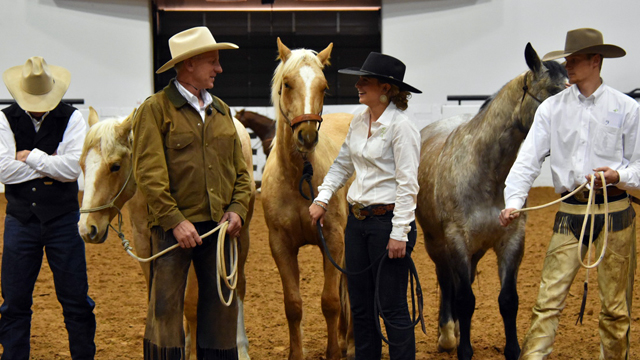The 2017 (seventh annual) Legacy of Legends will be held March 3 – 5 at the Will Rogers Event Center in Fort Worth, Texas. This year, the main attraction is an invitation-only colt starting demonstration. More than 30 participants have been invited to start young horses during the three-day event.
“Ray’s favorite part of the clinics was always the colt starting,” says Carolyn Hunt.
Carolyn was speaking about her late husband, the celebrated horseman Ray Hunt. She and horsemanship clinician Buck Brannaman are the founders of the Legacy of Legends, an event created to remember, showcase, and further the teaching and principles of two legendary horsemen, Tom Dorrance and Ray Hunt.
“He always contended that the most important thing you could do for your horse was to give him a good start,” Carolyn explains. “He said it pretty much determined what the rest of that horse’s life was going to be if you could get some confidence and some trust between the horse and the rider that first ride, and get that horse to mentally turn loose and let down physically.
“We were just talking about how Ray would perceive what we were doing with these clinics and with the foundation, and we thought this year we would go back to the beginning. Buck has an invitational colt starting, so he has a lot of young people that he sees over the year when he’s starting horses. We decided to invite some of these young horsemen that are all kind of at a different place in their horsemanship or in their horse careers. They all have something that is very commendable in what they’re getting done with their horses. So we decided to put together an invitation colt starting.”
Carolyn often gets asked by people across the country for information on who to go to for horse help in their regions. This year’s event is a way for folks to come and see many capable horsemen and horsewomen that are scattered from Canada to Mexico.
“We are going to start out with Buck doing a demonstration with a colt,” she says. “That sets the stage and it gives everybody a little bit of time to relax and let down. When he’s finished, we’ll have two round pens and we’ll have two people in each round pen for a period of time. This isn’t a competition in any sense of the word. At this event we’re stressing, ‘let’s put this horse first.’ If he needs a little more time, give him that time because you don’t have to do anything the first day, you’re going to have two more days. And at the end of three days, if you still haven’t got on your horse, that’s okay because all we’re showing is where you are at and where the horse is at. But in the mean time, when each of these young people are out there doing a presentation, you’re going to have Buck and Bill [Smith—a PRCA World Champion Saddle Bronc Rider] and myself in the arena, and we’ll be making comments and suggestions, and Buck will be there if someone needs some help.”
Below we provide mini-profiles of a handful of the more than 30 hands who will be starting colts at the Legacy of Legends this year to provide an idea of the kinds of participants attendees can expect to see at work.
Sheryl and Tiffany McLaury
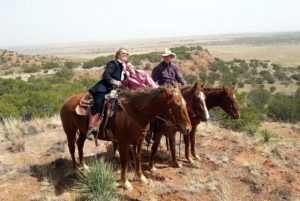
Among the colt starting demonstrators this year at the Legacy of Legends is a mother/daughter team—Sheryl and Tiffany McLaury. Sheryl’s husband (and Tiffany’s father) is cowboy, horsemanship clinician, and familiar face at the Legacy event, Buster McLaury. Sheryl and Buster work together throughout the year, and Tiffany often gets hired on to help them start colts.
“We’re going to be together [during the Legacy event], but we’ll have separate colts,” Sheryl says. “We were both lucky to be invited by Carolyn Hunt.”
Sheryl was raised on a ranch in Paducah, Texas and was always around horses. Buster grew up on the famed Four-Sixes Ranch in Guthrie, Texas. They have been married for 40 years and raised Tiffany, who is now 37, in ranch country.
“I don’t ever remember not being around horses,” Tiffany reflects. “Of course, Mom and Dad were working on different ranches and I was raised in that lifestyle and was always around horses. I was able to be around cutting horses when I was young. They’ve just always been a major part of my life. I start a bunch of colts for people and ride horses for people. Especially in the winter time, I work for Mom and Dad. We go to several big horse ranches and start a bunch of colts every winter—easily two or three hundred every winter.”
Sheryl and Tiffany bring to the Legacy of Legends direct knowledge of Ray’s horsemanship.
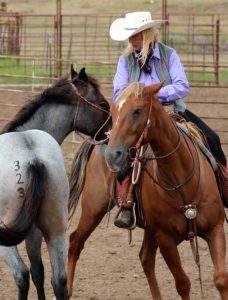
“Buster and I, we’ve known Carolyn and Ray before he passed, it’s been over 30 years,” Sheryl says. “Tiffany and I, we feel real honored to be starting colts, and mother and daughter getting to do it—we’re thrilled about it!”
“Of course, I was young when Mom and Dad met Ray,” Tiffany says. “Later on, I did get to ride a couple times with Ray in some clinics that Mom and Dad hosted.”
Tiffany explains that Sheryl, Buster, and she try to take Ray’s teachings to heart, and that they try their best to honor what he knew and taught.
“I think it comes through with everything that they and I do,” Tiffany says. “For me, it’s just getting a horse to try—trying to convey what you want to the horse in a way that he understands it. And, watching your thought become his thought. Getting a horse to try is one of the main things. Even if he does ‘the wrong thing’ from what you were asking, I think it’s noticing those little things he does try to do and then working with that to get what you initially wanted in the first place. I think that part sticks out to me more than anything, just getting one to try.
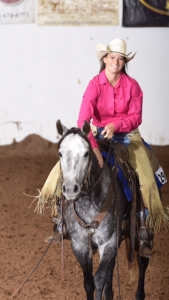
“I’m extremely honored to be invited. This is what I do for a living and I take it very seriously. I try to learn what I can from who I can and remain true to what I learned from Mom and Dad and Ray. So I think it’s just a huge honor to be included in this and to get to show what I have taken from these teachings and to learn from everybody else who is there. I know I can learn from them, so I’m excited for that opportunity as well.”
Sheryl agrees.
“It’s a big honor that we got invited and especially Tiffany and I getting invited at the same time. People are saying, ‘It’s a mother and daughter team and it’s a great thing,’ and I think it is, that we can work together and help each other, and that’s the nice thing about the deal—it’s not a competition. And, it shouldn’t be. It’s different folks out there showing what they can offer to other people. Hopefully the folks that are watching can go away with something that will work for them in the long run if they want to start a horse, or even if they work with horses in general they can have something to go with. I know that there’s a lot of fine folks that are participating in this deal and we’re looking forward to it. We all work together to help each other with the same common goal to help the horse. We want to do the best we can and really try to keep to Ray’s teaching.”
Learn more at busterandsherylmclaury.com.
Barb Gerbitz
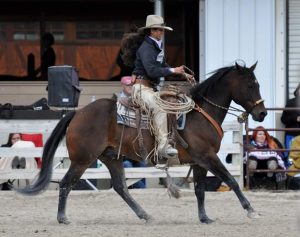 Barb Gerbitz was nominated to be invited to start a colt in this year’s Legacy event by a student of hers. She had ridden with Buck Brannaman for many years, so her work was familiar to him.
Barb Gerbitz was nominated to be invited to start a colt in this year’s Legacy event by a student of hers. She had ridden with Buck Brannaman for many years, so her work was familiar to him.
“I run a small training facility,” Barb says. “I’ve been starting colts for the public as a business for the past 20 years. I started my formal training at Blackhawk College in Galva, Illinois back in 1997. From there I went on to a bigger school and got a bachelors degree, but I started colts through college to get through, and I just loved it so much. It’s what I’ve just done. I do a lot of studying of Ray Hunt’s work. I’m one of the people who are in this Legacy who have not studied with Tom or Ray. But, I do study everything that I can get my hands on of theirs. I primarily study in person with Buck.”
Barb owns Gerbitz Quarter Horses in Tampico, Illinois and grew up in Oak Park, Illinois. She really didn’t do much with horses before going to college. She began in a pre-vet program at Blackhawk College in her home state, and she saw that they had a horse program.
“I thought that looked interesting,” Barb says. “I figured I would learn how to ride and I could teach kids at summer camps or something like that. And, they had a colt starting class. It was just one of the many different equine classes that they taught. When I took that class and I started my first colt with my instructor, Donna Irvin, that was it! I was totally fascinated with the process and by these young horses and how that you could get a horse from not understanding what a halter was and how to lead and be handled by a human to where you could be on their backs and get them to go around willingly was very fascinating to me. The process of teaching them, watching them learn, and I wanted to know why and how was that possible? So I just stayed with that topic for the next 20 years until now.”
Blackhawk College provided work study opportunities for students to equine farms and training facilities, and Barb went to Weatherford, Texas and worked at the Bar H Ranch, a cutting facility. She also worked for a reining, hunt seat, western pleasure facility in Iowa. After graduation, she worked for a trainer in Illinois.
“At each of these barns I didn’t ride the discipline,” Barb says, “I rode their colts because that was what I requested when I signed up, because that’s all I had my head on. That’s all I wanted to do and experiment with and learn more about, so of course they were very happy to let me ride their young horses because they would rather have somebody else fool with the babies. They wanted to get to the refinement work. Then I ended up getting out on my own.”
Now at 44, Barb has started thousands of colts.
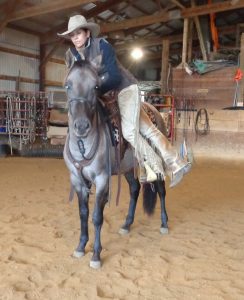 “It’s really all consuming for me,” she says. “That’s why people bring horses to me. I was here trying to figure out a lot of things on my own and I’d run into trouble and that was how I first reached out and met Buck Brannaman in person, because I did have a horse that was kind of what I’d call a back breaker. Over the years I’ve gone to other clinics where he gives me a little piece of advice and I take it very literally and I work on it. He’s kind of given me an excellent focal point—a way that works for me. I’ve just aspired to be as good for horses as Buck has become, and I know that his main mentor was Ray.
“It’s really all consuming for me,” she says. “That’s why people bring horses to me. I was here trying to figure out a lot of things on my own and I’d run into trouble and that was how I first reached out and met Buck Brannaman in person, because I did have a horse that was kind of what I’d call a back breaker. Over the years I’ve gone to other clinics where he gives me a little piece of advice and I take it very literally and I work on it. He’s kind of given me an excellent focal point—a way that works for me. I’ve just aspired to be as good for horses as Buck has become, and I know that his main mentor was Ray.
“From Ray–I’ve watched his videos and I have picture images that run through my head whenever I’m working any horse and I try and use that information. But, the biggest thing that I’ve learned from Ray is that it’s not about me. And if you kind of give yourself away and devote your time and energy to listening to that animal and trying to figure out exactly what they need, and when they need it, and how they need it, you’re going to help him faster when you stop thinking about what you need. And with Tom, just to slow down—to not expect things to shape up instantaneously unless you slow down and observe what’s going on, pick up on the patterns, and then make the adjustment from there. Those are the biggest things that I remember that I’ve taken away and used.”
Learn more at gerbitzquarterhorses.com.
Ricky Quinn
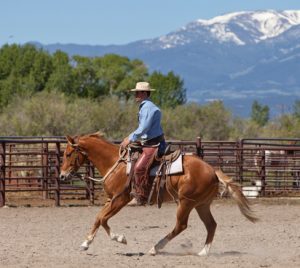
www.bitterrootequinephotos.smugmug.com
“I come from central Wyoming,” says Ricky Quinn. “My family were ranchers or worked for ranchers there. I was able to grow up around livestock.”
Ricky balances his time now between buying and selling stocker cattle when at home on his ranch in North Platte, Nebraska and traveling extensively teaching horsemanship clinics.
“My junior and senior year of high school I was living on my own and putting myself through high school there in Ten Sleep, Wyoming which is just 90 miles due west of Buffalo, Wyoming, which is 30 miles south of Sheridan where Brannaman is from,” Ricky explains. “One of the ranches that I was working for, I was starting their young horses for them. This was about 1998, and that’s when The Horse Whisperer was coming out, and I had never heard of the movie, or Brannaman, or Ray Hunt, or any of it. And, the owner of the ranch sent me to spectate Brannaman’s clinic for a couple of days.”
At that time, Ricky was lined-up to go to Minnesota to be a pipeline welder.
“The ranching background for me was kind of ‘angry’—hard on livestock, hard on people, and I just didn’t really know if that’s what I wanted to do,” he says. “So, I was going to go be a pipeline welder. I went to see Brannaman. I remember him riding a great big three-year-old bay horse that had hurt a lot of people on the place, and by the third day, Brannaman was roping the other colts off of him. At that time for me, that looked like magic. How he was at that time with the horses, how he talked to the people, it really hit home with me.”
Ricky wanted to go to work for Buck. But it was Buck’s wife Mary who lined up a job for Ricky at McGinnis Meadows in Libby, Montana with Shayne Jackson.
“This was just when Shayne was going to turn it into the guest ranch that it is now,” Ricky says, “and all the cabins were just a pile of logs sitting there. So, Shayne hired me on in 1999 when I graduated high school and I worked for him for nine years. Through working for him, I got to know Brannaman a little better. I went on the road with Brannaman for seven weeks one time—threw my duffle bag in and jumped in the truck one early spring—and we got to go by and hang out with Ray. I’d seen him a couple of other times, but I never really got to know Ray. I’ve gotten to know Ray through these other guys.”
Ricky is 36, and has been to all of the Legacy of Legends events to date.
“I love roping, and just horsemanship in particular,” Ricky says. “I like just being a good cowboy. The colt starting is just part of it for me. How you get those youngsters started is instrumental in how the rest of their life goes—it’s a big deal. For me, it was starting a young horse, doing a job on a young horse, and a lot of the roping. So those are the things that I focus 99 percent of my time on.”
Ricky considers the Legacy of Legends to be enjoyable family time as well as a great opportunity to see and share in the horsemanship of Tom and Ray.
“What I’m looking forward to is my family is going to be there,” he says. “My wife, my boys, I’ve got some friends and their wives and kids are going to be there, and we’ve got so many friends that have come up through this together—the camaraderie with the guys that I know. And there’s going to be a lot of guys on that list [starting colts] that I have met before a long time ago, or I don’t know them, and I can’t wait to just get to visiting with those guys and hanging out with them. I just really enjoy the event. I like what it stands for. I’m really happy that they’re bringing a lot of different guys in this time and giving them an opportunity to be there in honor of this horsemanship.”
Learn more at rickyquinnclinics.com.
Kip Fladland
 “I worked and traveled with Buck for several years, years ago,” says Kip Fladland.
“I worked and traveled with Buck for several years, years ago,” says Kip Fladland.
Kip co-owns La Riata Ranch in Griswold, Iowa with his wife, Missy. Kip starts colts, rides problem horses, and teaches clinics around the country.
“Although I’ve been involved with [the Legacy of Legends] for quite a few years on different deals,” Kip says, “it’s still a big deal for me to be able to go there and start a colt and show folks who might not ever have had that opportunity to ride or work with Ray—and nowadays maybe not even be able to get in to ride a horse with Buck, frankly because it’s pretty competitive to get into his clinics anymore, too. Being asked to come do something [at the Legacy], whatever it is, is sure enough a big deal.”
The range of ages and experience in the field of 30+ colt starters presenting this year is vast. Kip represents not only the more experienced end of the spectrum in general with over 30 years of experience working with horses on ranches and elsewhere, including five years of working with Buck Brannaman on the road, he, unlike many of those participating, brings direct knowledge of Ray Hunt and Tom Dorrance to the arena.
“I did get an opportunity to ride in quite a few clinics with Ray,” Kip says, “even before he kind of quit riding because of his health. I never had the chance to see Tom horseback, but I did get the honor to be able to visit with him on a couple of different occasions at his house in California when I was working and traveling with Buck. That was sure a pleasure to do. In the grand scheme of things, in my age bracket, I’m one of the few guys or gals who actually did get to ride with Ray Hunt. I’ll be 48 in September.”
When asked what influence Ray had on his horsemanship, Kip answers:
“Not to do too much, because he was a big advocate on not doing too much and still being able to get the job done. He figuratively always talked about people getting a bigger stick, or a bigger bit, bigger spurs, or whatever, but he was certainly not an advocate of any of that. A lot of times I can hear him telling us in a clinic or wherever we might have been, ‘Hey, that’s enough,’ or ‘You’re doing too much.’ I would quit this side of that next time. That’s the words that have rung true a number of times for me over the years.”
Kip grew up riding horses in Montana since his grandparents on both sides of the family had working ranches in that state.
“When I was in high school I had an opportunity to work for a guy who was showing AQHA horses,” he says. “He had gone to school with Brannaman and had been to several Ray Hunt clinics, so he kind of showed me real basic things, but certainly a different way than what I had grown up doing. And that would have been in 1985, but I didn’t meet Buck until the fall of 1991, and I went to my first Ray Hunt clinic in 1990 or so.
“Without a doubt, regardless of your discipline, or riding, or your thoughts on what a horse is supposed to do for the rest of his life, starting him as a colt is the most impressionable chance you’re ever going to have on him. So it’s a big deal, and right or wrong, depending upon how you do it is going to stick with him the rest of his life.”
Learn more at La Riata Ranch.
Carlos Mancera Esquivel
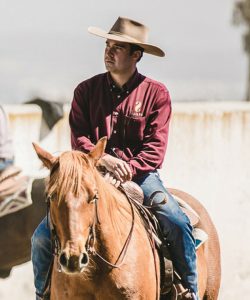 “My family, we are a three-generation family of charros in Mexico,” says Carlos Mancera Esquivel.
“My family, we are a three-generation family of charros in Mexico,” says Carlos Mancera Esquivel.
Carlos is a Legacy of Legends scholarship recipient who spent three months last year working with horsemanship mentors in the United States. He has been invited back to start a colt in this year’s event.
“I used to practice [with horses] a lot when I was a kid,” Carlos says. “I have pictures of me riding horses since I was a year old. But then, I didn’t like the environment of the whole tradition because they were loosing track of the heritage, the purpose of charros. I was like 10 years old at that time. So, I quit riding horses probably until I was 21—occasionally I rode horses on the ranch, but not very much.”
Carlos pursued a professional life in Mexico City and became a political consultant. At the height of his career, he was a consultant to the mayor of Mexico City.
“I did a lot of stuff that I thought I was good at,” he says. “But, it didn’t make me happy or even feel good. I thought that the political thing could change lives for the better, but it was a mess and so stressful to be part of it. So horses came into my life and kind of saved me from being not in a good emotional state.”
Carlos is now 31, but he was 26 when he left politics and the city to return to the ranch and work with horses.
“Since five years ago,” he says, “horses have been like my teachers and my guides to get along better with everyone in general with life. It was tiny things that got connected. The beginning was my coming back to the ranch and getting involved with horses. I wanted to do trail rides for tourists. So, I thought I knew about horsemanship, and one horse came and he really showed me that I didn’t know anything.”
In Mexico, Carlos says there are only a few horsemen who are teaching the kind of horsemanship that he is interested in learning.
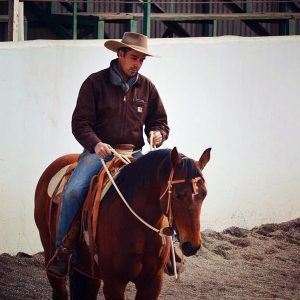 “One is my mentor, Alfonso Aguilar,” Carlos says. “He worked with Pat Parelli and met Tom and Ray. So, I went to one clinic [of his] and they played that documentary about Buck and they organized a trip, probably like 15 or 20 other Mexicans that I didn’t know, to the Legacy that was in 2015 in Forth Worth. When we went to Fort Worth, I wasn’t even that excited because I thought it was like not real until I came to the arena and I was super excited when I saw Buck or Nick Dowers or Joe Wolter. Then I found out about the scholarship program. I was 29 at the time. I said, ‘Well, I don’t know if I’m too old—I’m Mexican but the language barrier is not too hard for me—I don’t know if I should apply?’ So I made it a goal to apply and I kept in mind what I wanted. I gave it a shot and luckily things worked pretty well for me.”
“One is my mentor, Alfonso Aguilar,” Carlos says. “He worked with Pat Parelli and met Tom and Ray. So, I went to one clinic [of his] and they played that documentary about Buck and they organized a trip, probably like 15 or 20 other Mexicans that I didn’t know, to the Legacy that was in 2015 in Forth Worth. When we went to Fort Worth, I wasn’t even that excited because I thought it was like not real until I came to the arena and I was super excited when I saw Buck or Nick Dowers or Joe Wolter. Then I found out about the scholarship program. I was 29 at the time. I said, ‘Well, I don’t know if I’m too old—I’m Mexican but the language barrier is not too hard for me—I don’t know if I should apply?’ So I made it a goal to apply and I kept in mind what I wanted. I gave it a shot and luckily things worked pretty well for me.”
Carlos won the Western Horseman magazine sponsorship so he had the opportunity to have a three month scholarship.
“I went for two weeks with Buck—I took two clinics, one colt starting at his ranch and then I went with him for another clinic the next week,” Carlos says. “Then I went with Jaton Lord for like a month and a half in his place where he trains near Prescott, Arizona. Then I went with Joe Wolter for the last one. So I finished with him in early September.”
Carlos was invited to start a colt this year when he was with Jaton and Carolyn discussed the prospect with him.
“She told me if I could, I should go to the Legacy to give some words about my experience. I said, ‘Yeah, of course!’ And she told me, ‘If everyone is okay with it and goes, well maybe you could have a chance to start a colt.’ I think it was in December that I got a message from Jaton, ‘Hey man, would you like to start a colt at the Legacy?’ And, I was almost crying with emotion. I said, ‘Well yeah, that would be the best experience to finish this learning process that just evolved really quick.’ That would be a good way to wrap up this scholarship deal that I got.”
Once Carlos got exposed to the kind of horsemanship promoted by Tom and Ray, his goals became to keep learning about it and improving, but also to share it with others in Mexico.
“That would bring a good change here in Mexico because we have really good roots about getting along with horses but we kind of forgot our heritage,” Carlos says. “Since three years ago, I’ve been boarding horses as part of my income and I have a small ranch here. I train my own horses. And since I got back, people are asking me to give clinics—so that’s funny because now more than ever I feel like a beginner, so I always tell them, ‘I can share with you what I know, but what I don’t know, we will figure it out together.’ So my plan is to keep doing it and keep taking clinics in the States. This year my goal is to go back and take a Harry Whitney clinic.” Carlos is very honored to be asked to start a colt this year.
“All the guys that are in the lineup, they’re really good hands but the best things about this gathering is that I don’t feel like this is any show or exhibition,” he says. “It’s more like a learning process because I know those guys are going to help me, or we can help each other if we have some problems. That’s why I don’t get so nervous, otherwise I would be really nervous. I think about this more like a family reunion than many shows or exhibitions. I’m super excited to be part of the family.”
To find out more about Carlos, please visit his business facebook page: “LASSO Horse & Life.”

